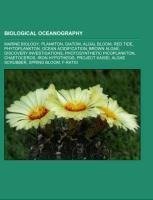
-
 Anglický jazyk
Anglický jazyk
Biological oceanography
Autor: Source: Wikipedia
Source: Wikipedia. Pages: 63. Chapters: Marine biology, Plankton, Diatom, Algal bloom, Red tide, Phytoplankton, Ocean acidification, Brown algae, Discovery Investigations, Photosynthetic picoplankton, Chaetoceros, Iron Hypothesis, Project Kaisei, Algae scrubber,... Viac o knihe
Na objednávku, dodanie 2-4 týždne
18.00 €
bežná cena: 20.00 €
O knihe
Source: Wikipedia. Pages: 63. Chapters: Marine biology, Plankton, Diatom, Algal bloom, Red tide, Phytoplankton, Ocean acidification, Brown algae, Discovery Investigations, Photosynthetic picoplankton, Chaetoceros, Iron Hypothesis, Project Kaisei, Algae scrubber, Spring bloom, F-ratio, Marine snow, Diel vertical migration, Defying Ocean's End, Continental shelf pump, Polar seas, Bioturbation, Picoeukaryote, Biological pump, List of eukaryotic picoplankton species, Frustule, Zooplankton, Global Ocean Data Analysis Project, World Ocean Atlas, Center for Microbial Oceanography: Research and Education, Picobiliphyte, Microphyte, Productivity, Paradox of the plankton, Coscinodiscophyceae, Artificial seawater, James Johnstone, Hawaii Ocean Time-series, Sediment trap, Nitzschia, Sea snot, Milky seas effect, Bacteriastrum, Raphidophyte, Eustigmatophyte, Bermuda Atlantic Time-series Study, Attheya, Bacterioplankton, Pennales, SUPER HI-CAT, Remineralisation, Apparent oxygen utilisation, Gelatinous zooplankton, Chaetoceros furcellatus, Journal of Applied Ichthyology, Chaetocerotaceae, Attheya septentrionalis, Pyramimonas tetrarhyncus, Chaetoceros diadema, Heterotrophic picoplankton, Thin layers, Navicula, Thalassiosira pseudonana, Biddulphiophycidae, Coscinodiscophycidae, Attheya decora, Attheya longicornis, Benthic lander, Attheya arenicola, Attheya flexuosa, Attheya armata, Manta trawl, Attheya gaussii, Bacteriastrum delicatulum, Rhizosoleniophycidae, Pseudoplankton. Excerpt: Ocean acidification is the name given to the ongoing decrease in the pH of the Earth's oceans, caused by their uptake of anthropogenic carbon dioxide from the atmosphere. Between 1751 and 1994 surface ocean pH is estimated to have decreased from approximately 8.25 to 8.14, representing an increase of approaching 30% in "acidity" (H ion concentration) in the world's oceans. The cycle between the atmosphere and the oceanThe carbon cycle describes the fluxes of carbon dioxide () between the oceans, terrestrial biosphere, lithosphere, and the atmosphere. Human activities such as the combustion of fossil fuels and land use changes have led to a new flux of into the atmosphere. About 45% has remained in the atmosphere; most of the rest has been taken up by the oceans, with some also taken up by terrestrial plants. The carbon cycle involves both organic compounds as well as inorganic carbon compounds such as carbon dioxide and the carbonates. The inorganic compounds are particularly relevant when discussing ocean acidification for it includes the many forms of dissolved present in the Earth's oceans. When dissolves, it reacts with water to form a balance of ionic and non-ionic chemical species: dissolved free carbon dioxide (), carbonic acid (), bicarbonate () and carbonate (). The ratio of these species depends on factors such as seawater temperature and alkalinity (see the article on the ocean's solubility pump for more detail). Carbonate system of seawaterDissolving in seawater increases the hydrogen ion () concentration in the ocean, and thus decreases ocean pH. Caldeira and Wickett (2003) placed the rate and magnitude of modern ocean acidification changes in the context of probable historical changes during the last 300 million years. Since the industrial revolution began, it is estimated that surface ocean pH has dropped by slightly more than 0.1 units on the logarithmic scale of pH, representing an approximately 29% increase in , and it is estimated that it will dro
- Vydavateľstvo: Books LLC, Reference Series
- Rok vydania: 2012
- Formát: Paperback
- Rozmer: 246 x 189 mm
- Jazyk: Anglický jazyk
- ISBN: 9781155326306



 Nemecký jazyk
Nemecký jazyk 







